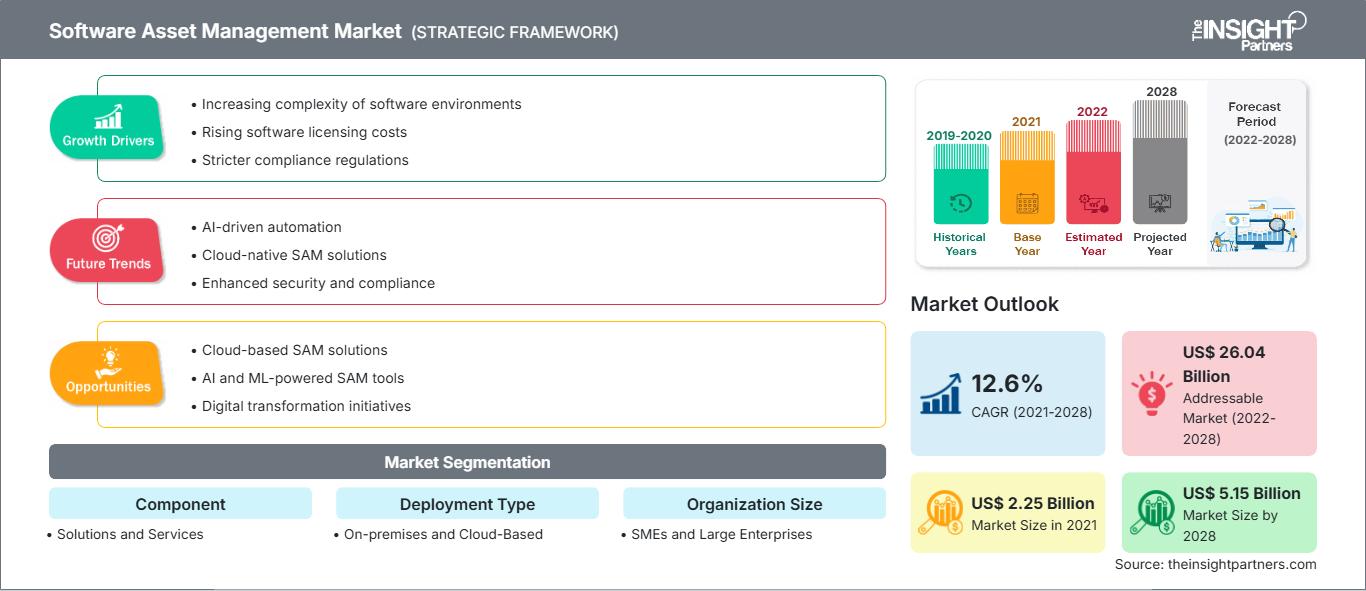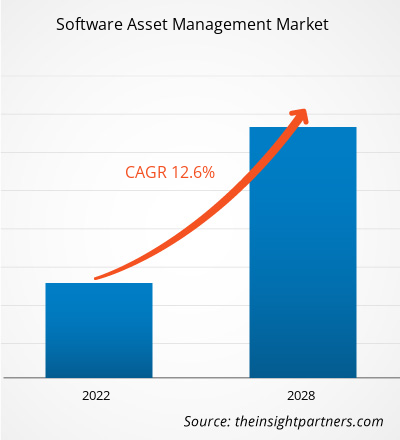[調査レポート]ソフトウェア資産管理市場は、2021年の22億5,037万米ドルから2028年には51億5,051万米ドルに成長すると予想されており、2021年から2028年にかけて12.6%のCAGRで成長すると予測されています。
組織内でのソフトウェアアプリケーションの取得、導入、使用、保守、廃棄を可能にするシステム、ルール、手順の管理は、ソフトウェア資産管理(SAM)と呼ばれています。ソフトウェア資産管理市場は、企業がライセンス契約を遵守し、ソフトウェアに過剰な支出をしないことを保証することを目的としたIT資産管理の構成要素です。ソフトウェア資産の識別、エンドユーザー使用許諾契約(EULA)の有効性、フリーソフトウェアの適切な使用は、いずれもSAMの取り組みにおける重要な目標です。 SAMドキュメントは、著作権侵害訴訟から企業を守り、意図しないライセンスの不正使用を最小限に抑え、ネットワーク上のシャドーソフトウェアを制御できるようにします。
大規模組織におけるソフトウェア資産管理は非常に複雑になる場合があり、ソフトウェアの購入、サブスクリプション、ライセンス、パッチに関する情報を管理するデータベースの開発と維持が必要になります。このようなチームは、ソフトウェアライセンスの更新、新しいライセンス契約の交渉、ほとんどまたは全く使用されていないソフトウェアの検出と削除を担当することがよくあります。ソフトウェア資産管理市場では、購入されたソフトウェアライセンスの数を監査し、インストールされたライセンスの数と照合することで、モバイル、デスクトップ、データセンター、クラウドなど、多数のインベントリソースから情報を取得する方法を自動化します。SAMツールは、残りのライセンス数を追跡することもできます。経費を削減するために、この情報を利用して、使用されていないソフトウェアを削除または再割り当てすることができます。
要件に合わせてレポートをカスタマイズ
レポートの一部、国レベルの分析、Excelデータパックなどを含め、スタートアップ&大学向けに特別オファーや割引もご利用いただけます(無償)
ソフトウェア資産管理市場: 戦略的洞察

-
このレポートの主要な市場動向を入手してください。この無料サンプルには、市場動向から見積もりや予測に至るまでのデータ分析が含まれます。
COVID-19パンデミックによるソフトウェア資産管理市場への影響
COVID-19パンデミックは、ソフトウェア資産管理市場に好影響を与えました。企業は、COVID-19パンデミックにより、リモートワーク環境の整備など、新たな課題に直面しています。COVID-19の流行は、ライセンスとコストを最適化し、IT資産のROIを向上させるために、デジタル技術を導入し、ソフトウェア資産管理ソリューションとサービスの潜在能力を活用する必要性を浮き彫りにしました。さらに、2020年のパンデミックの到来は、世界の市場運営に多くの課題をもたらしました。先進国の医療インフラは感染者数の増加により崩壊しているため、公的医療の緊急事態により、政府と市場関係者は、2028年に終了する予測期間中に損失を回復するための研究開発イニシアチブの共同作業を通じて、市場運営と収益の回復に介入し支援する必要がある。さらに、投資の増加は、今後数年間の業界にとって良い前兆となる。
市場洞察 - ソフトウェア資産管理市場
資産ライフサイクル管理の必要性の高まりがソフトウェア資産管理市場の需要を押し上げる
すべての手順とITインフラストラクチャのユーザーは、会社のソフトウェア資産をライフサイクル全体にわたって管理、規制、および保護する必要があります。IT資産管理(ITAM)、ITサービス管理(ITSM)、およびハードウェア資産管理(HAM)はすべて、ソフトウェア資産管理(SAM)のサブセットです。ITAMは、コスト削減を最適化し、監査リスクを制限しながら、ソフトウェアおよびハードウェア資産管理を改善することを目的としています。現代の企業は、ソフトウェアを日常業務に不可欠な要素と考えています。平均して、組織は従業員の様々な業務を支援するために288個のアプリケーションを導入しています。資産ライフサイクル管理(LCAM)を適切に導入することで、企業は資産がピークパフォーマンスを発揮する時期と、ビジネスにどれだけの期間貢献できるかを戦略的に判断できます。例えば、Blissfullyはソフトウェア資産管理およびSaaS(Software as a Service)管理アプリケーションであり、コスト削減、すべてのソフトウェアプロバイダーの管理、生産性向上、ソフトウェアシステムのセキュリティ強化に役立ちます。このように、資産ライフサイクル管理のニーズが高まるにつれて、ソフトウェア資産管理市場の需要も高まっています。
コンポーネントセグメントの洞察 - ソフトウェア資産管理市場
コンポーネントに基づいて、ソフトウェア資産管理市場はソリューションとサービスに分類されます。ソフトウェア資産管理ソリューションは、データセンター運用管理者がすべての資産を特定、特定、視覚化、管理し、将来の成長に向けたキャパシティ計画を立てるのに役立ちます。ソフトウェア資産管理プログラムの導入には、取得したソフトウェアライセンスの数と実際に消費または使用されたライセンスの数を一致させるという戦略的な目的があります。効果的なソフトウェア資産管理プログラムは、インストールされているすべてのソフトウェアが個々のベンダーのライセンス契約の条件に従って使用されていることを確認し、購入ライセンス数と消費量のバランスをとる必要があります。ソフトウェアベンダーやビジネスソフトウェアアライアンス(BSA)などの第三者による監査を受けることで、企業はソフトウェアの著作権侵害に関連する責任を軽減できます。
導入タイプ別セグメントの分析 - ソフトウェア資産管理市場
導入タイプに基づいて、ソフトウェア資産管理はオンプレミスとクラウドベースに分類されます。クラウドベースのソフトウェア資産管理ソリューションは、画面サイズの異なる様々なデバイス(デスクトップ、ラップトップ、タブレット、携帯端末、スマートフォン)での使用に便利です。RFID、バーコード、NFCのデータもクラウドに保存できるため、簡単に取得できます。クラウドベースのシステムは、アクセスが容易なため、複数の拠点での資産監査や、内部監査と外部監査の組み合わせに最適です。通常、多くのデバイスから資産の写真をアップロードしたり、コメントを追加したりするのが簡単です。クラウドベースのソフトウェア資産管理ソリューションは、バージョン管理、監査、および複数の承認チェーンを容易に実現できます。
組織タイプ別セグメントの洞察
組織タイプに基づいて、ソフトウェア資産管理市場は中小企業と大企業に分類できます。大企業は、社内の生産性を向上させるために、ハイエンドソフトウェアに多額の投資を行うことができます。より大規模な企業にはSAMツールが必要です。ソフトウェア資産管理ツールを使用することで、手動プロセスを自動化、加速、および改善できます。さらに、ソフトウェア資産管理は、さまざまな業種の組織がIT資産のパフォーマンスと俊敏性を効果的に向上させるのに役立ちます。
業種別セグメントの洞察 - ソフトウェア資産管理市場
業種別に、ソフトウェア資産管理市場は、政府、小売・消費財、ヘルスケア・ライフサイエンス、BFSI、メディア・エンターテインメント、製造、IT・通信、その他に分類されています。デジタルテクノロジーは、製造業のビジネスアプローチを変革しています。インダストリー4.0では、テクノロジーが大きな役割を果たすと予測されています。ソフトウェア資産管理は、この新しい製造業の時代の重要な要素となるでしょう。
プレーヤーは、競争優位性を実現するために、高度なテクノロジーと機能を統合することで、新製品のイノベーションと開発に注力しています。テクノロジーインテリジェンスの世界的リーダーであるSnow Softwareによると、Snow Atlasは、オンプレミスとクラウドの両方で企業がテクノロジー投資を特定、監視、最適化できるようにゼロから開発された唯一の統合プラットフォームです。サービスとして提供されるソフトウェアおよび資産管理(SAM)、ソフトウェア・アズ・ア・サービス(SaaS)管理、ITサービス管理(ITSM)統合は、新しいクラウドネイティブプラットフォームで利用できる最初のソリューションであり、ソフトウェアアクセス管理ソリューションに含まれています。
コンポーネントに基づいて、ソフトウェア資産管理市場はソリューションとサービスに分類されます。導入タイプでは、オンプレミスとクラウドベースに分類されます。組織タイプでは、ソフトウェア資産管理市場は中小企業と大企業に分類できます。ソフトウェア資産管理市場は、業種別に見ると、政府機関、小売・消費財、ヘルスケア・ライフサイエンス、BFSI、メディア・エンターテインメント、製造業、IT・通信、その他に分類されます。地域別に見ると、世界のソフトウェア資産管理市場は、北米、ヨーロッパ、アジア太平洋地域、中東・アフリカ、南米に分類されます。
ソフトウェア資産管理市場
ソフトウェア資産管理市場
予測期間を通じてソフトウェア資産管理市場に影響を与える地域的な傾向と要因については、The Insight Partnersのアナリストが詳細に解説しています。このセクションでは、北米、ヨーロッパ、アジア太平洋、中東・アフリカ、中南米におけるソフトウェア資産管理市場のセグメントと地域についても解説しています。
ソフトウェア資産管理市場レポートの範囲
| レポート属性 | 詳細 |
|---|---|
| の市場規模 2021 | US$ 2.25 Billion |
| 市場規模別 2028 | US$ 5.15 Billion |
| 世界的なCAGR (2021 - 2028) | 12.6% |
| 過去データ | 2019-2020 |
| 予測期間 | 2022-2028 |
| 対象セグメント |
By コンポーネント
|
| 対象地域と国 |
北米
|
| 市場リーダーと主要企業の概要 |
|
ソフトウェア資産管理市場のプレーヤー密度:ビジネスダイナミクスへの影響を理解する
ソフトウェア資産管理市場は、消費者の嗜好の変化、技術の進歩、製品メリットへの認知度の高まりといった要因によるエンドユーザー需要の高まりに牽引され、急速に成長しています。需要の高まりに伴い、企業は提供内容の拡充、消費者ニーズへの対応のためのイノベーション、そして新たなトレンドの活用を進めており、これが市場の成長をさらに加速させています。

- 入手 ソフトウェア資産管理市場 主要プレーヤーの概要
ソフトウェア資産管理市場 –会社概要
- マイクロソフト株式会社
- IVANTI
- スノーソフトウェア
- BMC ソフトウェア株式会社
- CERTERO
- FLEXERA
- IBM Corporation
- MICRO FOCUS
- SERVICENOW
- BROADCOM、株式会社
- 過去2年間の分析、基準年、CAGRによる予測(7年間)
- PEST分析とSWOT分析
- 市場規模価値/数量 - 世界、地域、国
- 業界と競争環境
- Excel データセット
最新レポート
関連レポート
お客様の声
購入理由
- 情報に基づいた意思決定
- 市場動向の理解
- 競合分析
- 顧客インサイト
- 市場予測
- リスク軽減
- 戦略計画
- 投資の正当性
- 新興市場の特定
- マーケティング戦略の強化
- 業務効率の向上
- 規制動向への対応






















 無料サンプルを入手 - ソフトウェア資産管理市場
無料サンプルを入手 - ソフトウェア資産管理市場